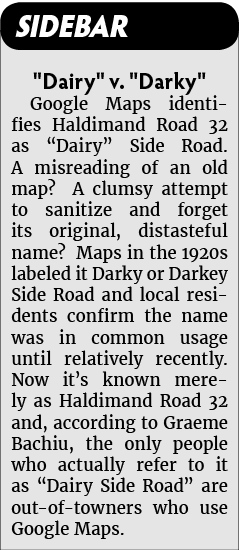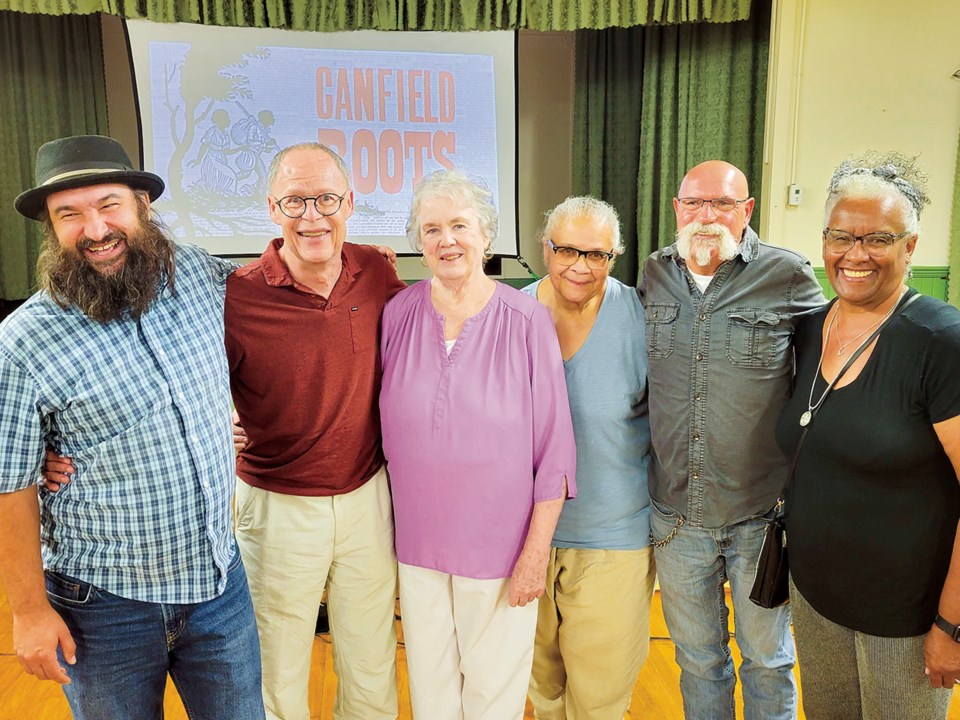Documentary traces routes of Black freedom seekers who settled in west Niagara
There was no red carpet, no posing starlets, no swarming paparazzi, but the debut showing of Graeme Bachiu’s documentary “Canfield Roots” in the Canfield Community Centre was met with all the emotion, enthusiasm, and applause deserving of a world premiere. The documentary traces the history of the once vibrant Black community of escaped slaves and their descendants in and around Canfield, a small community about half an hour due west of Fenwick.
Local historian Sylvia Weaver has been compiling the history of the Black community in Canfield and area for six years. Three years ago she met Graeme Bachiu, the principal filmmaker of Windecker Road Films and a resident of Canfield, who became equally fascinated by the little-known history of the Black community. Relying on Weaver’s exhaustive research, Bachiu launched into a project to tell the story of the Freedom Seekers and their descendants on film, and along the way has become a passionate advocate for the preservation of their history.
“Canfield Roots” is the result of their collaboration and enthusiasm. Originally a six-part television series that has aired on Bell Vibe and across the US on PBS, it has been painstakingly edited and restructured to become a 75-minute documentary for theatrical release. Bachiu chose the Canfield Community Centre for the premiere of his documentary as the most appropriate venue for its first public showing. Like any director about to show his “labour of love” for the first time publicly, Bachiu was nervous.
“I’ll probably hide for the first 15 minutes, but gradually I’ll calm down and come out,” he said.
At the end, he was happy with both the film and the reaction, “But I spent the whole time doing mental revisions and re-edits.”
The documentary tells the story of how, beginning in 1836 and continuing through the 1840s and ‘50s, escaped slaves made their way north on the Underground Railroad, a secret chain of safe-houses and pathways, to Canada and freedom. Many settled in St. Catharines, where the famous Harriet Tubman led a large community of former slaves and actively assisted their escape across the border, making 19 trips into the US herself to shepherd them north. With bounty hunters active in the border towns, many moved inland and settled in the largely unpopulated areas along the Talbot Trail (now Highway 3). About 20 families settled in and around Canfield.
Recognized as the father of the Black community, Stepaney Street, learning he was about to be sold by his West Virginia owner and separated from his family, escaped in 1840 and crossed into Canada near Windsor. His wife Lucy and her three children, enslaved at a different plantation in West Virginia, escaped three weeks later and made their way on the Underground Railroad to cross Lake Erie at Point Abino and find shelter in St. Catharines. The two were reunited shortly after and moved to Canfield, where they established a farm and a community, built a home and a church, and raised 13 children. There they were joined by other fugitive slaves and by 1851 the census revealed 137 Black settlers in Canfield. The Emancipation Proclamation and the end of the Civil War in the United States opened the door for many to return, while others moved on from the hard-scrabble farms of Haldimand into the cities. By 1911 only 52 remained, and the last of the descendants of the Black Freedom Seekers left Canfield in 1998.
This has brought us together for the first time and given us a sense of pride in who we are and where we came from
In a question period following the screening, Bachiu was joined on stage by historian Silvia Weaver and Canfield Freedom Seeker descendants Spencer Matin, Aileen Duncan, Bill Douglas, and Karen Springer. It was Bill Douglas, the last Black resident of Canfield, who articulated the importance of the film to the descendants, who are now scattered across Canada from New Brunswick to Vancouver Island and throughout the US.
“This has brought us together for the first time and given us a sense of pride in who we are and where we came from.”
Martin Spencer agreed: “Making this film has been an emotional experience for all of us.”
He marveled at the strength and determination of his ancestors to escape slavery to freedom and create from nothing a vibrant community.
“This film is a celebration of what people can accomplish,” he said.
Aileen Duncan revealed that the documentary had kindled a pride in her extended family, resulting in a planned reunion of the Duncan and Street families from across Canada to be held at the Canfield Community Centre in August.
Pride in their heritage was an important theme for all the descendants, who had experienced some form of discrimination and prejudice.
“I don’t blame Canfield,” said Bill Douglas’s sister, Betty-Ann Newman, on film from her home in Spokane Washington. “We were unaware of our differences through our early years.”
It was only when she went to high school, Newman said, that her race became an issue. She left Canfield on her 20th birthday and sought the anonymity of the big city.
“In Toronto I took all those labels and threw them out the door.” A happily married mother and grandmother, she has been reluctant to talk about the painful past, but now she proudly shows pictures of her mother, grandmother, and great- grandmother to her grandchildren, and takes pride in the perseverance, strength, and fortitude of her ancestors.
While the Black community in Canfield is no more, Bachiu has built his documentary around the metaphor of an abandoned cemetery in a copse of woods in a farm field on the outskirts of town. The cemetery is on land once owned by Stepany and Lucy Street and contains the remains of many of the earliest Black settlers. On repeated visits to the graveyard, Bachiu and some of the descendants gradually uncovered gravestones engraved with the names of the early families. One of the earliest discoveries was the grave of Carrie Harper, niece of Harriet Tubman.
In Toronto I took all those labels and threw them out the door
Other discoveries followed, including last year, as descendant Aileen Duncan was sitting on her walker, watching Bachiu’s film crew taping in the cemetery, when she noticed the stone under her foot had a straight edge. Assisted by the cameraman, she scraped away the vegetation and moss to reveal the gravestone of her great-great-great-grandfather, Stepaney Street. Since then, more graves have been identified, and records indicate that 11 bodies are buried in the plot, but Sylvia Weaver believes there may be more. According to her research there may be as many as six Black cemeteries hidden away in woods and fields in the Canfield area.

Thanks to the attention brought to the small, derelict graveyard by “Canfield Roots,” the County of Haldimand is in the process of acquiring the wooded property and preserving it as a significant historic site. The Bereavement Authority of Ontario, the government’s official overseer of cemeteries and burial sites, is expected to formally recognize the site, and negotiations are underway with the Ministry of Transportation to provide access off Haldimand Road 32, once called “Darky Side Road.” A plaque describing the importance of the cemetery is planned, the gravestones will be restored, and the plot cleared while preserving its natural setting.
Graeme Bachiu is very pleased with the success of his six-part television series so far.
“National exposure on PBS in the US was huge,” he said, “and the first episode on Vibe got over 10,000 views in Canada.”
But he has hopes that the just-released standalone documentary will reach other audiences in schools, theatres, and film festivals. Meanwhile, the cameras were rolling during the screening at the Canfield Community Centre, and as plans to save the cemetery progress and the Black descendants of the early Freedom Seekers reconnect and regain their heritage, he hopes to continue documenting their story and produce more episodes in the series.



